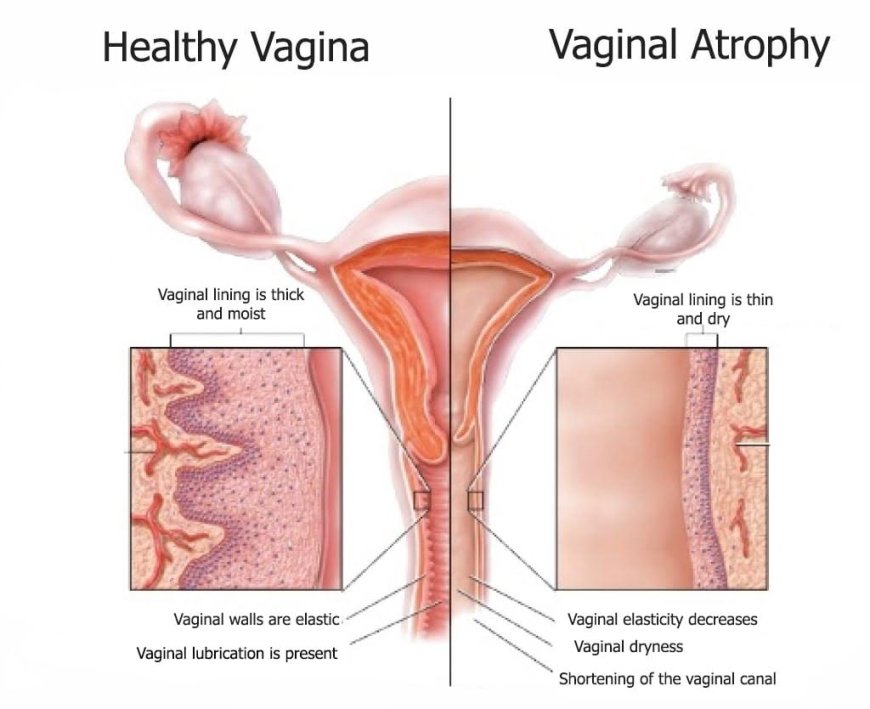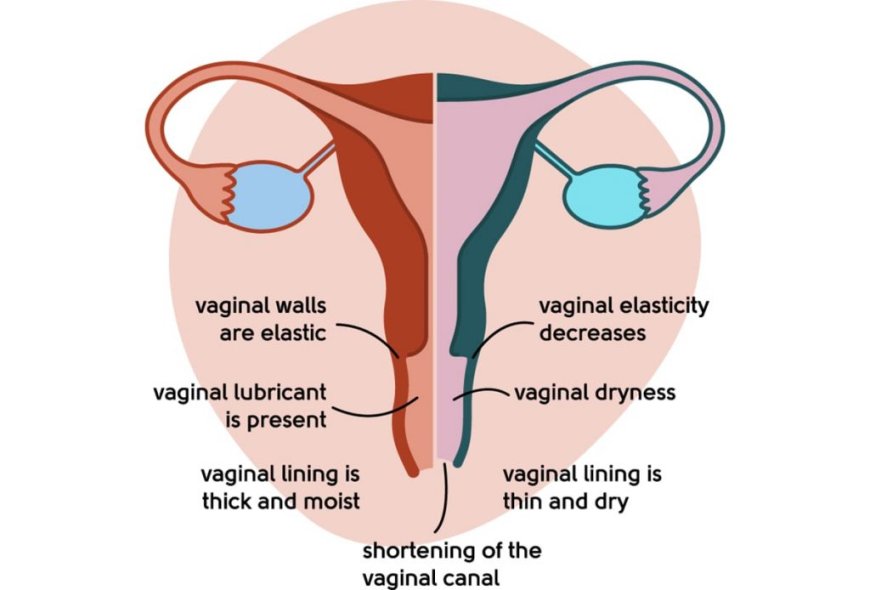"Beyond Lubrication: Managing Vaginal Atrophy For Better Intimacy"
Learn about vaginal atrophy, a common condition that can cause discomfort and pain during sexual activity. Explore various ways to manage and treat the condition beyond traditional lubrication methods, for a better and more fulfilling sexual experience.
Vaginal atrophy, also known as atrophic vaginitis or urogenital atrophy is a common condition that affects many women as they age. This condition is characterized by a thinning, drying, and inflammation of the vaginal walls due to a decrease in estrogen levels, which can lead to a range of uncomfortable symptoms.
Cause of vaginal atrophy
Vaginal atrophy is primarily caused by a decrease in estrogen levels, which can occur as a natural part of the aging process or due to other factors such as:
- Menopause: The most common cause of vaginal atrophy is menopause, which is the natural decline in estrogen levels that occurs as a woman ages. Menopause can cause vaginal dryness, thinning of the vaginal walls, and a decrease in natural lubrication.
- Breastfeeding: Breastfeeding can also cause a decrease in estrogen levels, which can lead to vaginal dryness and atrophy.
- Cancer treatments: Certain cancer treatments such as radiation therapy and chemotherapy can cause a decrease in estrogen levels, which can lead to vaginal atrophy.
- Surgical menopause: Surgical menopause, which occurs when the ovaries are surgically removed, can cause a sudden decrease in estrogen levels and lead to vaginal atrophy.
- Certain medications: Certain medications, such as those used to treat breast cancer, can cause a decrease in estrogen levels and lead to vaginal atrophy.
- Smoking: Smoking has been linked to an increased risk of vaginal atrophy, as it can cause decreased blood flow to the vagina and a decrease in estrogen levels.
- Genetics: Some women may be more predisposed to vaginal atrophy due to genetic factors.
It's important to note that while a decrease in estrogen levels is the primary cause of vaginal atrophy, there may be other underlying medical conditions that can contribute to the condition. It's important for women to talk to their healthcare providers if they are experiencing symptoms of vaginal atrophy to rule out other possible causes and explore treatment options.
Symptoms of vaginal atrophy
Symptoms of vaginal atrophy can vary from person to person but may include vaginal dryness, itching, burning, soreness, pain during sexual intercourse, and vaginal discharge. These symptoms can not only be uncomfortable but can also impact a woman's quality of life, relationships, and sexual health.
When to see a doctor
It is recommended that women should see a doctor if they experience any symptoms of vaginal atrophy, such as vaginal dryness, itching, burning, soreness, pain during sexual intercourse, or vaginal discharge.
Women should also see a doctor if they experience any bleeding after sexual intercourse or have any unusual vaginal bleeding or discharge, as these may be signs of other medical conditions that require treatment.
If a woman has recently entered menopause, it is also recommended that she schedule a visit with her doctor to discuss any potential risks and treatment options for vaginal atrophy.
Furthermore, women who are undergoing cancer treatments, have had a hysterectomy or any other pelvic surgery, or have a history of breast cancer should speak with their healthcare provider about their risk for vaginal atrophy and what measures they can take to prevent or manage the condition.
Overall, it's important for women to talk to their healthcare provider if they experience any symptoms of vaginal atrophy or have any concerns about their vaginal health. A healthcare provider can perform a physical examination and may recommend additional testing or refer the patient to a specialist for further evaluation and treatment.
Risk Factors
There are several risk factors that can increase a woman's likelihood of developing vaginal atrophy. These include:
1. Hysterectomy: Women who have had a hysterectomy may also be at an increased risk for vaginal atrophy, as the surgery can affect blood flow and estrogen production in the vaginal area.
2. Lack of sexual activity: A lack of sexual activity or vaginal stimulation can also contribute to vaginal atrophy by causing a decrease in blood flow to the vaginal area.
3. Cancer treatments: Certain cancer treatments such as radiation therapy and chemotherapy can cause a decrease in estrogen levels, which can lead to vaginal atrophy.
4. Surgical menopause: Surgical menopause, which occurs when the ovaries are surgically removed, can cause a sudden decrease in estrogen levels and lead to vaginal atrophy.
5. Certain medications: Certain medications, such as those used to treat breast cancer, can cause a decrease in estrogen levels and lead to vaginal atrophy.
6. Smoking: Smoking has been linked to an increased risk of vaginal atrophy, as it can cause decreased blood flow to the vagina and a decrease in estrogen levels.
7. Genetics: Some women may be more predisposed to vaginal atrophy due to genetic factors.
8. Menopause: The natural decline in estrogen levels that occurs during menopause is the most common cause of vaginal atrophy.
9. Breastfeeding: Breastfeeding can also cause a decrease in estrogen levels, which can lead to vaginal dryness and atrophy.
Complications
Untreated vaginal atrophy can lead to several complications, including:
- Painful sex: Vaginal atrophy can cause discomfort or pain during sexual intercourse, making sexual activity difficult or even impossible.
- Urinary tract infections (UTIs): The thinning of the vaginal walls and a decrease in natural lubrication can increase a woman's risk of developing UTIs, which can be uncomfortable and potentially serious if left untreated.
- Vaginal infections: Vaginal atrophy can increase a woman's risk of developing vaginal infections such as bacterial vaginitis and yeast infections.
- Urinary incontinence: The weakening of the pelvic muscles and changes to the urinary tract can increase a woman's risk of urinary incontinence, or the involuntary loss of urine.
- Vaginal bleeding: Women with vaginal atrophy may experience bleeding after sexual intercourse or other activities that cause vaginal trauma.
- Decreased quality of life: The symptoms of vaginal atrophy, such as pain and discomfort during sex, can impact a woman's overall quality of life and mental health.
It's important for women to seek treatment for vaginal atrophy if they experience any symptoms or complications. Treatment can help alleviate symptoms and reduce the risk of complications. If left untreated, vaginal atrophy can lead to further health issues and decrease a woman's overall quality of life.
Lifestyle
There are several lifestyle changes that women can make to reduce their risk of developing vaginal atrophy or alleviate symptoms if they are already experiencing it. These include:
- Engage in regular sexual activity: Sexual activity can help increase blood flow to the vaginal area, which can improve vaginal health and reduce the risk of vaginal atrophy. It's important to use appropriate lubrication and practice safe sex to avoid any potential irritation or infection.
- Stay hydrated: Drinking plenty of water can help keep the body hydrated and promote natural lubrication in the vaginal area.
- Quit smoking: Smoking has been linked to an increased risk of vaginal atrophy, as it can cause decreased blood flow to the vagina and a decrease in estrogen levels.
- Maintain a healthy diet: A healthy, balanced diet that includes plenty of fruits, vegetables, and whole grains can help promote overall health and support vaginal health.
- Exercise regularly: Exercise can help improve blood flow and promote overall health. Pelvic floor exercises, in particular, can help strengthen the muscles that support the bladder and vagina.
- Manage stress: Stress can affect hormone levels in the body, which can impact vaginal health. Finding ways to manage stress, such as through exercise, meditation, or therapy, can help promote overall health and support vaginal health.
- Use vaginal moisturizers or lubricants: Vaginal moisturizers or lubricants can help alleviate vaginal dryness and improve overall vaginal health.
Making healthy lifestyle choices can help promote overall health and support vaginal health. If you are experiencing symptoms of vaginal atrophy or have concerns about your vaginal health, it's important to speak with your healthcare provider. They can provide recommendations for treatment and help you make any necessary lifestyle changes.
Conclusion
Vaginal atrophy is a common condition that affects many women, particularly those who are postmenopausal or have undergone cancer treatment. Symptoms can include vaginal dryness, itching, and discomfort during sexual activity, and can lead to complications such as painful sex, urinary tract infections, and vaginal bleeding. However, there are several treatment options available, including hormone therapy, vaginal moisturizers or lubricants, and lifestyle changes such as regular sexual activity and pelvic floor exercises. It's important for women to discuss any concerns or symptoms with their healthcare provider and to undergo regular pelvic exams to monitor their vaginal health. With appropriate treatment and lifestyle changes, women can alleviate symptoms and improve their overall vaginal health and quality of life.
What's Your Reaction?












































